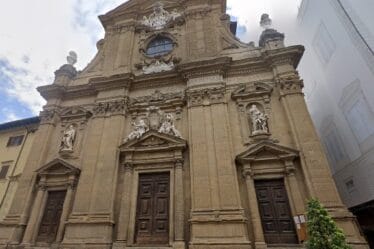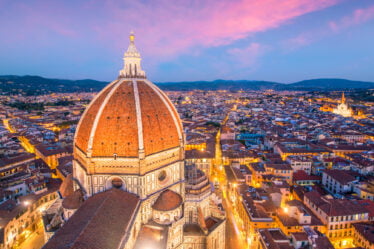
Well yes … even Michelangelo is indeed … perhaps it would be better to say, what remains of his project to the unfinished facade of S.Lorenzo. It all starts when Pope Leo X returns to Florence on a solemn visit and seeing the facade of S.Lorenzo, is tormented by an idea, that of creating a facade worthy of the oldest church in the city. So what is better than to announce a competition regarding the facade, so as to increase the fame of the Medici family, also given that they were the financiers of the Brunelleschiana Basilica. The best artists, such as Antonio and Giuliano da Sangallo, Jacopo Sansovino, Baccio d’Agnolo and to end the great Raffaello, in short people of little account! Perhaps at the beginning of Michelangelo the task of supervising the marble decoration of the facade is entrusted, but in 1516 thanks also to its influence of the Medici family, she managed to obtain the assignment among a thousand controversies.
But this task was not absolutely easy, indeed difficult, so much so that the design had various phases in creating a suitable solution for the church in the master’s imagination. This competition had a sort of architectural constraints, in the sense that the facade had to correspond in an almost perfect way with the internal proportions of the building. Perhaps Michelangelo also took inspiration from the projects presented by the “colleagues” opponents, and as the inspiration of the great artist is known, it is also seen in the project preceding the work. The sheets of the drawings and the wooden model for the facade preserved in the Museum of the Buonarroti house, make us understand Michelangelo’s vision which partly resolves the thorny question of the church front, his mind creates a structure so as to make it look more like a building private that a basilica.
It seems that in 1520 Michelangelo recorded the termination of the contract for the supply of marble, the one that was already deposited for the construction was used to pave the cathedral of S.Maria del Fiore. The documents of the time narrate that the works are very slowly, but the almost total blockage of everything takes place in December 1521 when Pope Leo X dies. It will be necessary to wait for the pontificate of Pope Clement also VII of the Medici family, the Which show the will to finish the blessed facade, it must also be remembered that our Michelangelo was committed to the realization of the new sacristy of S.Lorenzo. The death of Clemente VII took place in September 1534, establishes the definitive closure of the S.Lorenzo construction site and as we see even today remained as it was at 1534. But what does Michelangelo hit in the Donatello square?
After this long premise we come to the point, passing or rather by saying along Piazzale Donatello side via degli Artisti, have you ever noticed by two cornerstones partially underground in the middle of the benches? These capitals used as a comfortable seat or a makeshift table to make a picnic or snack, were identified on the basis of a comparison with another specimen, such as those of the project never finished by the great Michelangelo for the facade of S.Lorenzo.
For a long time they were used as models for students of the Academy of Drawing, and then were subsequently placed in the nineteenth century as a decoration of the square. Perhaps it would have been better to keep them in the cloister of S.Lorenzo, mah …. not comment !! .. also interesting and also that the architect Cola of the Amatrice was commissioned, in the first half of the sixteenth century, to retouch the facade of the Basilica of S. Bernardino in L’Aquila, taking inspiration from a project never made by Michelangelo Buonarroti for the Basilica of San Lorenzo in Florence, the works began in 1525 to be completed in 1542. But let’s go back to us, if you pass in that area, maybe Give a remarkable two -piece glance also given the size of our past put a little on the sidelines.
Join us for an immersive exploration of this timeless city’s rich history, art, and culture on our acclaimed Free Walking Tour! As you gather in the historic Santa Maria Novella Square, you’ll be surrounded by the iconic landmarks that define Florence’s essence. From the majestic Basilica of Santa Maria Novella to the bustling streets teeming with life, the stage is set for an adventure like no other. Our Florence free tour, led by our experienced local guides, you’ll uncover the hidden gems and storied past of Florence as we traverse through its cobblestone pathways. our meeting point is in front of Minerva hotel.



